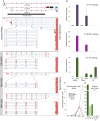Global transcript structure resolution of high gene density genomes through multi-platform data integration
- PMID: 27407110
- PMCID: PMC5062983
- DOI: 10.1093/nar/gkw629
Global transcript structure resolution of high gene density genomes through multi-platform data integration
Abstract
Annotation of herpesvirus genomes has traditionally been undertaken through the detection of open reading frames and other genomic motifs, supplemented with sequencing of individual cDNAs. Second generation sequencing and high-density microarray studies have revealed vastly greater herpesvirus transcriptome complexity than is captured by existing annotation. The pervasive nature of overlapping transcription throughout herpesvirus genomes, however, poses substantial problems in resolving transcript structures using these methods alone. We present an approach that combines the unique attributes of Pacific Biosciences Iso-Seq long-read, Illumina short-read and deepCAGE (Cap Analysis of Gene Expression) sequencing to globally resolve polyadenylated isoform structures in replicating Epstein-Barr virus (EBV). Our method, Transcriptome Resolution through Integration of Multi-platform Data (TRIMD), identifies nearly 300 novel EBV transcripts, quadrupling the size of the annotated viral transcriptome. These findings illustrate an array of mechanisms through which EBV achieves functional diversity in its relatively small, compact genome including programmed alternative splicing (e.g. across the IR1 repeats), alternative promoter usage by LMP2 and other latency-associated transcripts, intergenic splicing at the BZLF2 locus, and antisense transcription and pervasive readthrough transcription throughout the genome.
© The Author(s) 2016. Published by Oxford University Press on behalf of Nucleic Acids Research.
Figures







References
-
- Pattle S.B., Farrell P.J. The role of Epstein-Barr virus in cancer. Expert Opin. Biol. Ther. 2006;6:1193–1205. - PubMed
-
- Henle W., Henle G. Epstein-Barr virus and human malignancies. Cancer. 1974;34(Suppl. S4):1368–1374. - PubMed
-
- Longnecker R., Kieff E., Cohen J.I. Epstein-Barr Virus. In: Knipe DM, Howley PM, editors. Fields Virology. 6th edn. Philadelphia: Wolters Kluwer Health/Lippincott WIlliams & Wilkins; 2013. pp. 1898–1959.
-
- Baer R., Bankier A.T., Biggin M.D., Deininger P.L., Farrell P.J., Gibson T.J., Hatfull G., Hudson G.S., Satchwell S.C., Seguin C., et al. DNA sequence and expression of the B95-8 Epstein-Barr virus genome. Nature. 1984;310:207–211. - PubMed
MeSH terms
Substances
Grants and funding
LinkOut - more resources
Full Text Sources
Other Literature Sources
Medical
Molecular Biology Databases
Miscellaneous

